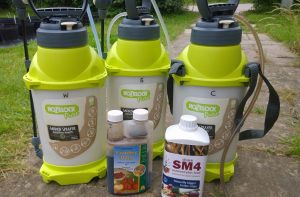This summer, we have been working in partnership with Hozelock to find out whether foliar feeding can increase your container plants’ provision for bees, by improving plant health and flowering, as well as the quantity and quality of pollen and nectar produced.
For the trial, we grew 48 tubs of nasturtium ‘Ladybird’, which received a weekly foliar feed of either comfrey liquid, seaweed feed, mains tap water (applied using Hozelock’s Pure sprayer) or no foliar feed.

You can read more about how we carried out the trial and foliar feeding in our previous blog posts and the full detailed results on our plant trials page.
What we found
Foliar feeding had no statistically significant effect on plant size, the number of flowers produced, or the visual quality of either the flowers or foliage.
The nectar from the flowers of plants that recieved the comfrey feed contained a slightly higher sugar content and these flowers also had a greater pollen volume, however the effects were not statistically significant. Foliar feeding also had no effect on pollen quality (assessed by measuring the percentage of carbon and crude protein).
The nasturtium flowers were visited by four species of bumblebee: the Garden Bumblebee (Bombus hortorum), Common Carder Bee (Bombus pascuorum), Buff-tailed Bumblebee (Bombus terrestris) and White-tailed Bumblebee (Bombus lucorum).

Bombus hortorum

Bombus pascuorum

Bombus terrestris/lucorum
Although we monitored the nasturtium plants for a total of six hours over four dates, we saw only 35 bumblebees make a total of 261 flower visits, which limited the analysis we were able to perform. When we examined the length of time the bumblebees spent collecting nectar and pollen from flowers in each treatment, foliar feeding had no statistically significant effect.
Interestingly, Garden Bumblebees made the greatest number of flower visits (78% of total visits). It is likely that the long 12mm tongue of the Garden Bumblebee allows it to reach deep inside the nectar producing spur of the nasturtiums, while nectar may not be as readily available to the short-tongued (6mm) Buff-tailed Bumblebees, unless the spur is very full.
Conclusions and recommendations
This trial has raised some very interesting questions for further research. It is likely that the effects of foliar feeding vary between plant species, and it is possible that nasturtiums fail to fully absorb the feeds due to the texture of their leaves.
It would be valuable to trial other popular garden plants with easily measured nectar and pollen, such as hardy geraniums (Geranium species), borage (Borago officinalis) and sages (Salvia species). Also, a wider range of commercial and home-made foliar feeds at varying concentrations could be trialled.

Despite the trial not generating significant results, foliar feeds remain a good way to deliver nutrients and give plants a quick pick-me-up. The Hozelock Pure sprayer was of excellent quality, easy to use and should last many growing seasons – we look forward to experimenting further with it in the future.
As well as bumblebees, our nasturtiums were visited by a wide variety of other insects, including honeybees (Apis mellifera), several small tortoiseshell butterflies (Aglais urticae), and many hoverfly species. Nasturtiums are a great, easy to grow plant, offering late summer resources for a range of pollinators.

Further details of our findings can be found on our plant trials page.

